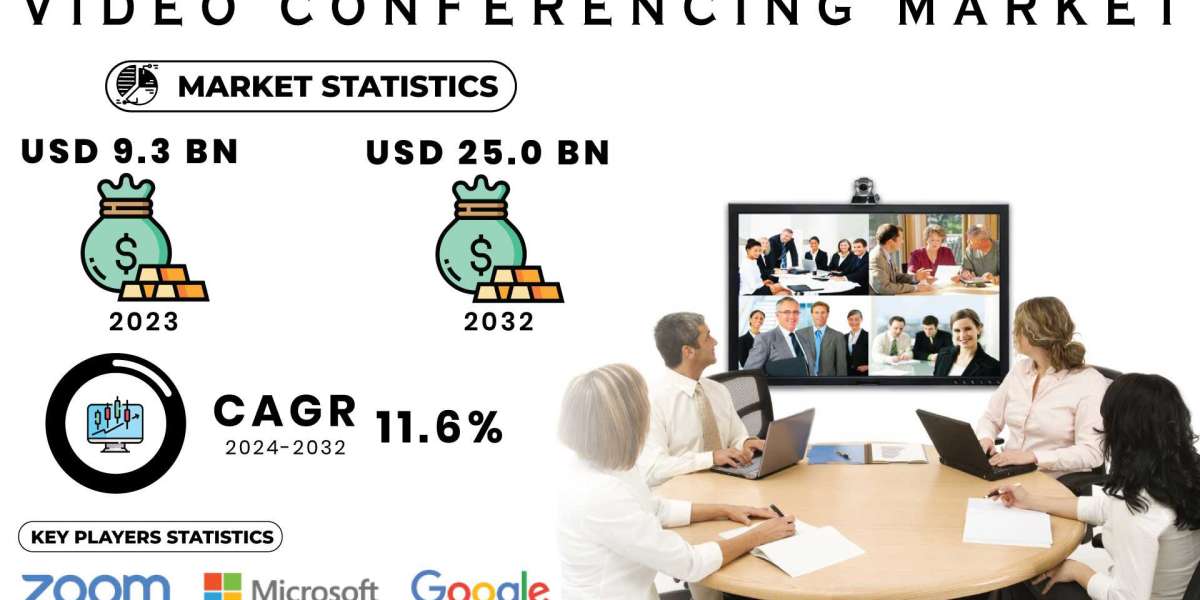Video Conferencing 2024
Video conferencing has revolutionized the way individuals and organizations communicate, offering seamless connectivity across the globe. As technology continues to advance, video conferencing has transformed from being a tool of convenience to an indispensable medium for businesses, education, and social interaction. The ability to host virtual meetings, conduct training, and collaborate in real-time has underscored the importance of this technology. Video Conferencing Market Trends reveal a growing reliance on these platforms due to remote work adoption, globalization, and advancements in communication technology.
Video Conferencing Market was valued at USD 9.3 billion in 2023 and is expected to reach USD 25.0 billion by 2032, growing at a CAGR of 11.6% from 2024-2032.
The Rise of Video Conferencing Platforms
The adoption of video conferencing has accelerated significantly in the past decade, driven by advancements in internet connectivity, cloud computing, and high-definition video technologies. Initially, video conferencing was a luxury available only to enterprises with substantial resources. However, the proliferation of affordable software solutions and hardware tools has democratized access, making it a vital resource for businesses of all sizes and individuals alike.
The global COVID-19 pandemic further accelerated the adoption of video conferencing solutions, as organizations and educational institutions shifted to remote operations. Platforms like Zoom, Microsoft Teams, and Google Meet became essential tools, enabling users to maintain productivity and connectivity during unprecedented times. Today, video conferencing has moved beyond being a contingency tool and has become integral to hybrid work models and digital-first strategies.
Applications Across Sectors
Video conferencing technology has diverse applications, spanning several industries. In the corporate world, it is used extensively for virtual meetings, interviews, training sessions, and collaboration with distributed teams. This has reduced the need for travel, leading to significant cost savings and environmental benefits.
The education sector has seen immense benefits from video conferencing. Online learning platforms leverage video communication to connect educators and students globally, fostering interactive learning experiences. From virtual classrooms to live tutoring, video conferencing has made education accessible and flexible.
In healthcare, video conferencing is playing a critical role in telemedicine. Patients can consult with doctors remotely, reducing the need for physical visits and enabling timely medical interventions. This is especially beneficial in rural or underserved areas where access to healthcare services may be limited.
The technology is also being utilized in events, entertainment, and social interactions. Virtual conferences, webinars, and online concerts have become commonplace, offering innovative ways to engage with audiences.
Key Growth Drivers
Several factors are driving the growth of the video conferencing market. The ongoing adoption of hybrid work models is a significant driver, as organizations strive to offer flexible work environments while maintaining productivity. Additionally, the increasing globalization of businesses has necessitated tools that can facilitate effective communication across geographies.
Technological advancements are also propelling the market forward. The integration of artificial intelligence (AI) into video conferencing platforms has enhanced features such as real-time transcription, noise cancellation, and virtual backgrounds. Similarly, the rise of 5G connectivity is enabling smoother video streaming and reducing latency, improving the overall user experience.
Challenges and Opportunities
While video conferencing has become ubiquitous, it is not without challenges. Privacy and security concerns remain critical issues, especially as sensitive business and personal information is exchanged over these platforms. Ensuring robust encryption and cybersecurity measures is paramount to gaining user trust.
Despite these challenges, the future of video conferencing is bright. The integration of virtual reality (VR) and augmented reality (AR) technologies is expected to create more immersive meeting experiences. Furthermore, the increasing emphasis on sustainability is likely to boost demand for video conferencing as an eco-friendly alternative to business travel.
Conclusion
Video conferencing has reshaped the way people communicate, collaborate, and learn. Its versatility and efficiency have made it an indispensable tool across various sectors, driving innovation and connectivity. As the video conferencing market continues to expand, advancements in technology and a growing focus on security will further enhance its impact, solidifying its role in the digital era.
Contact Us:
Akash Anand – Head of Business Development Strategy
info@snsinsider.com
Phone: +1-415-230-0044 (US) | +91-7798602273 (IND)
About Us
SS Insider is one of the leading market research and consulting agencies that dominates the market research industry globally. Our company's aim is to give clients the knowledge they require in order to function in changing circumstances. In order to give you current, accurate market data, consumer insights, and opinions so that you can make decisions with confidence, we employ a variety of techniques, including surveys, video talks, and focus groups around the world.
Read Our Other Reports:














